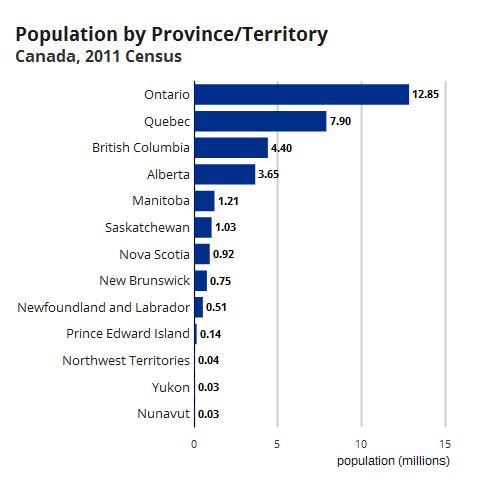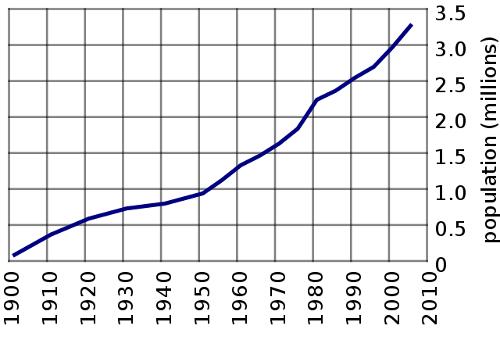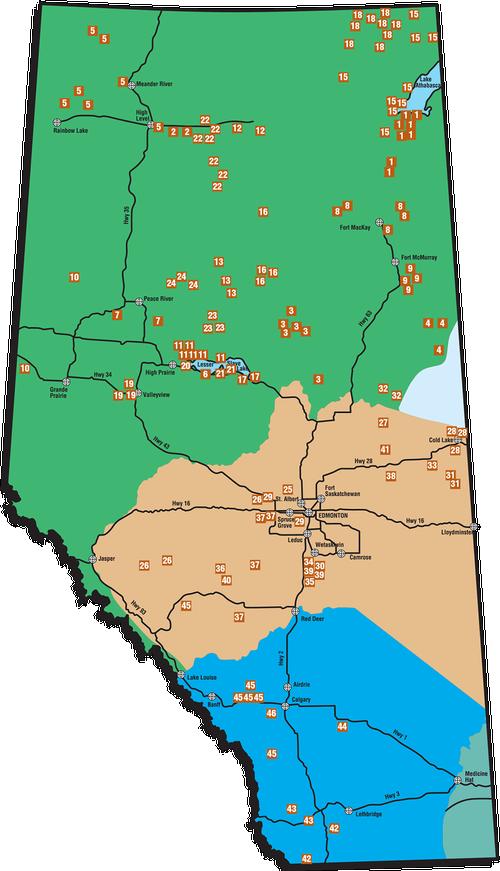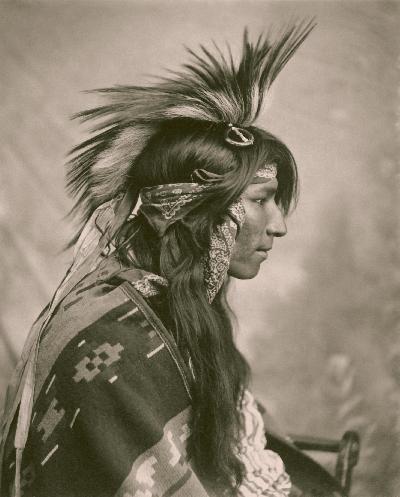ALBERTA
Population

Population
Popular destinations CANADA
| Alberta | British columbia | Manitoba |
| New brunswick | Newfoundland and labrador | Northwest territories |
| Nova scotia | Nunavut | Ontario |
| Prince edward island | Quebec | Saskatchwan |
| Yukon |
Population
 Alberta population (2011) compared to the other Canadian provincesPhoto: Srm038 CC 4.0 International no changes made
Alberta population (2011) compared to the other Canadian provincesPhoto: Srm038 CC 4.0 International no changes made
The population of Alberta was 4.8 million in 2024 and the population density was approximately 6 inhabitants per km2. As a result of the strong economic conditions, Alberta attracts many people from the other Canadian provinces and population growth is therefore higher than elsewhere in Canada.
For example, between 1996 and 2006, 469,095 people from Canada's other provinces migrated to Alberta and 261,500 people left the province to seek refuge in other provinces. Alberta has a total of 449 cities and towns.
 Population growth Alberta 1900-2010Photo: Casito at english wikipedia CC 3.0 no changes made
Population growth Alberta 1900-2010Photo: Casito at english wikipedia CC 3.0 no changes made
Population growth in the last hundred years has been spectacular, from 73,022 inhabitants in 1901 to 3,645,257 in 2011, an increase of 1.5% of the Canadian population to 10.9%. The population grew by more than 40% between 1991 and 2009. A city like Calgary also experienced several growth spells, after the oil discovery in 1947 and, for example, after the Arab oil boycott in the early 1970s. Then the city grew from 400,000 inhabitants in 1971 to far more than one million today. The population of Edmonton doubled in the period 1946-1956 to 254,800. The population of the tar-sands city of Fort McMurray increased from 1,500 in 1974 to 75,000 in 2014. An average income of 135,000 Canadian dollars in 2010, compared to 104,000 in Calgary and 94,000 in Toronto, will certainly have contributed to this spectacular population growth.
10 Largest Cities Alberta (ca. 2011)
| Calgary | 1.1 |
| Edmonton | 815,000 |
| Red Deer | 98,000 |
| Lethbridge | 90,000 |
| St. Albert | 61500 |
| Fort McMurray | 61190 |
| Medicine Hat | 60,000 |
| Grande Prairie | 55,000 |
| Airdrie | 42,500 |
| Spruce Grove | 26,500 |
Statistics Canada, the Canadian Bureau of Statistics, conducted an extensive study in 2014 into the development of the Canadian population for the next 25 years. For Alberta, it means that by 2038 the province will become the third largest province in Canada in terms of population, after Ontario and Quebec. Alberta is currently in fourth place after British Columbia. With a relatively young population, a relatively high fertility rate and substantial inland migration to Alberta, Alberta is expected to experience the greatest population growth of all provinces from just over four million in 2014 to between 5.6 and 6.8. million inhabitants in 2038.
Less than 20% of the population lives in rural areas, the rest in cities. The vast majority of people are of white or Native American descent and just over 10% are members of a minority group. The Edmonton/Calgary region is the most urbanized area in Alberta and is among the four most urbanized areas in Canada. In 2011, about 30% of the population lived in Calgary and about 25% in the capital Edmonton. Calgary is the second largest city in Canada after Toronto, Montréal and Vancouver, Edmonton is the fifth largest city.
Alberta currently has approximately 173,000 inhabitants of Dutch origin, who often live together. Villages such as Picture Butte, Monarch, Nobleford, Neerlandia and Strathmore consist largely of 'Dutch'.
Canadian native Indianpeoples, excluding Inuit and Mestizos or Métis, are called First Nations or 'First Nations'. In prehistoric times, Alberta tribes such as the Blackfoot, Kainaiwa, Siksika, Peigan, Atsina, Cree, Tsuu T'ina, Slavey, Dene and Assiniboine settled. According to a 2011 Canadian census, nearly 117,000 'Albertans' indicated that they belonged to one of the First Nations. Alberta thus has the third largest First Nations population of Canada, after Ontario and British Columbia, living in its territory. About half of these Indians live in a reservation, the rest just live among the rest of the Canadian population. Many of these urban Indians live in the capital Edmonton, the city with the most Indians after Winnipeg. In addition, there are some 20,000 Indians who have not registered themselves in the official 'Indian Register'.
There are currently 46 First Nations of "Bands" in Alberta, below an overview:
 First Nations Towns MapPhoto: Indigenousand Northern Affairs Canada in the public domain
First Nations Towns MapPhoto: Indigenousand Northern Affairs Canada in the public domain
| 1. Athabasca Chipewyan | 17. Sawridge Band | 33. Kehewin Cree |
| 2. Beaver | 18. Smith's Landing | 34. Louis Bull |
| 3. Bigstone | 19. Sturgeon Lake Cree | 35. Montana |
| 4. Chipewyan Prairie | 20. Sucker Creek | 36. O'Chiese |
| 5. Dene Tha ' | 21. Swan River | 37. Paul |
| 6. Driftpile | 22. Tallcree | 38. Saddle Lake Cree |
| 7. Duncan's | 23. Whitefish Lake | 39. Samson Cree |
| 8. Fort McKay | 24. Woodland Cree | 40. Sunchild |
| 9. Fort McMurray | 25. Alexander | 41. Whitefish Lake (Goodfish) |
| 10. Horse Lake | 26. Alexis Nakota Sioux | 42. Blood |
| 11. Kapawe'no | 27. Beaver lake | 43. Piikani |
| 12. Little Red River Cree | 28. Cold Lake | 44. Siksika |
| 13. Loon River | 29. Enoch Cree | 45. Stoney |
| 14. Lubicon Lake | 30. Ermineskin Cree | 46. Tsuu T'ina |
| 15. Mikisew Cree | 31. Frog Lake | |
| 16. Peerless Trout | 32. Heart Lake |
 Cree-IndianPhoto: Public domain
Cree-IndianPhoto: Public domain
Sources
Canada
Cambium
Canada
Lonely Planet
Hempstead, Andrew / Calgary
Avalon Travel
Hempstead, Andrew / Edmonton & Northern Alberta
Avalon Travel
Pashby, Christie / Frommer's Alberta
Wiley
Struijk, Aad / West-Canada
Elmar
Teuschl, Karl / Canada-West : Rocky Mountains, Vancouver
Uitgeverij Unieboek/Het Spectrum BV
Veldt, Marc / Canada
Gottmer/Becht
Wagner, Heike / West- Canada
Lannoo
Wikipedia
CIA - World Factbook
BBC - Country Profiles
Copyright: Team The World of Info